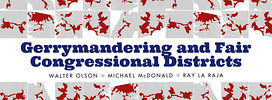As the conversation unfolds I see areas of agreement with Walter Olson and Michael McDonald. First, we all view the current state of political competition as suboptimal for a healthy democracy. Second, we agree on data transparency and trying to engage the public in the process. I am less sanguine, however, about prospects for removing politics from the process (more on that below). Finally, Olson and I – and probably McDonald – agree that ongoing experimentation is good. There is no consensus about which model of redistricting is better than others, so variation and probing of outcomes is good.
Here are key remaining points of difference. First, regarding the goal of increased competition I believe we need to be realistic about what can be accomplished through redistricting. I think Olson recognizes this but I am not sure about McDonald. By all means, look for geographic areas where it is possible to draw competitive districts, but it is not clear to me how many we can produce, given structural constraints like geography, and “neutral” guidelines required by courts and statutes.
Perhaps a better way to introduce competition than redistricting is to loosen the regulations on third parties so they can be more competitive in lopsided partisan districts. I am guessing that Olson would agree with me heartily on this. We should also consider changing the winner-take-all rule and possibly use ranked-choice to stimulate competition. If we can reduce the bipolar standoff between the major parties, we might increase political competition and reduce the high stakes for redistricting.
I also want to emphasize my skepticism that a reformed redistricting process will dampen polarization very much, as McDonald suggests. We observe ideologues running even in competitive districts. The lack of competition and increased polarization has antecedent roots, which redistricting is unlikely to address that much. For example, new research by Andrew Hall and Danielle Thomsen suggests that moderates are disappearing from the ranks of potential candidates primarily because party activists are very unfriendly to them and governing is not fun when leadership holds all the power. In this way, voters are offered choices that are already polarized.
The discussion of how candidates emerge raises a related point. Perhaps we focus too narrowly on the general election in debates over redistricting and fair representation, particularly if one believes that nominations tend to produce candidates who are very far from the median voter. If independent commissions are to play a larger role in redistricting, they might evaluate the make-up of primary electorates when designing districts, particularly when the primary election is de facto the one that picks the officeholder. When a district cannot be made two-party competitive it might be constructed in a way that does not necessarily give winning pluralities to the most partisan and ideological voters. I am not holding my breath on this. But as McDonald asks rhetorically, where are the districts for moderates and independents? Point well-taken.
A second difference I have with my colleagues is about the process itself. I argue that we should not try to sidestep politics, but to channel it. Unless we incorporate politics into the public bargaining process, its rivulets will submerge and resurface through interest groups with less accountability than parties and officeholders. By all means, continue developing criteria to attenuate the conflict of interest of politicians, but why not create an explicit Madisonian framework in which ambition is made to counteract ambition?
Highly polarized parties make it even more difficult to sidestep politics through independent commissions. The stakes are just too high. A small thumb on the scale can make a potentially balanced district tilt toward a conservative Republican or a liberal Democrat. More thumbs on the scale might ensure that majority power goes to a very conservative or very liberal party. In these circumstances, the parties will find surrogates or turn to the courts to wage their battles.
Instead, we should encourage a process by which each side – and the public – make iterative offers and counteroffers to move the process toward median positions that would lower the stakes. The commissions would then choose among the best plans that fit particular criteria rather than design the districts. As Bruce Cain argues, this would create incentives to build coalitions around plans rather than go to court in the service of parochial interests.
Many reformers have set up a false dichotomy based on what Christopher Achens and Larry Bartels call the folk theory of democracy. In this narrative, disinterested voters somehow make better choices than self-serving politicians. This is an unhelpful mythology. Either because of ignorance, manipulation, or their own self-interest, pure citizen commissions might bring as many problems to the table as officeholders or experts. Under poorly designed institutions, citizen commissions can produce outcomes that several groups think are unfair. And so the battle goes to the courts. The process repeats itself every decade and undermines its legitimacy. Any process should try to avoid the courts by lowering the stakes through bargaining.

